Aboriginal and Torres Strait Islander Health | Assignment
VerifiedAdded on 2022/09/07
|9
|2239
|20
AI Summary
Contribute Materials
Your contribution can guide someone’s learning journey. Share your
documents today.
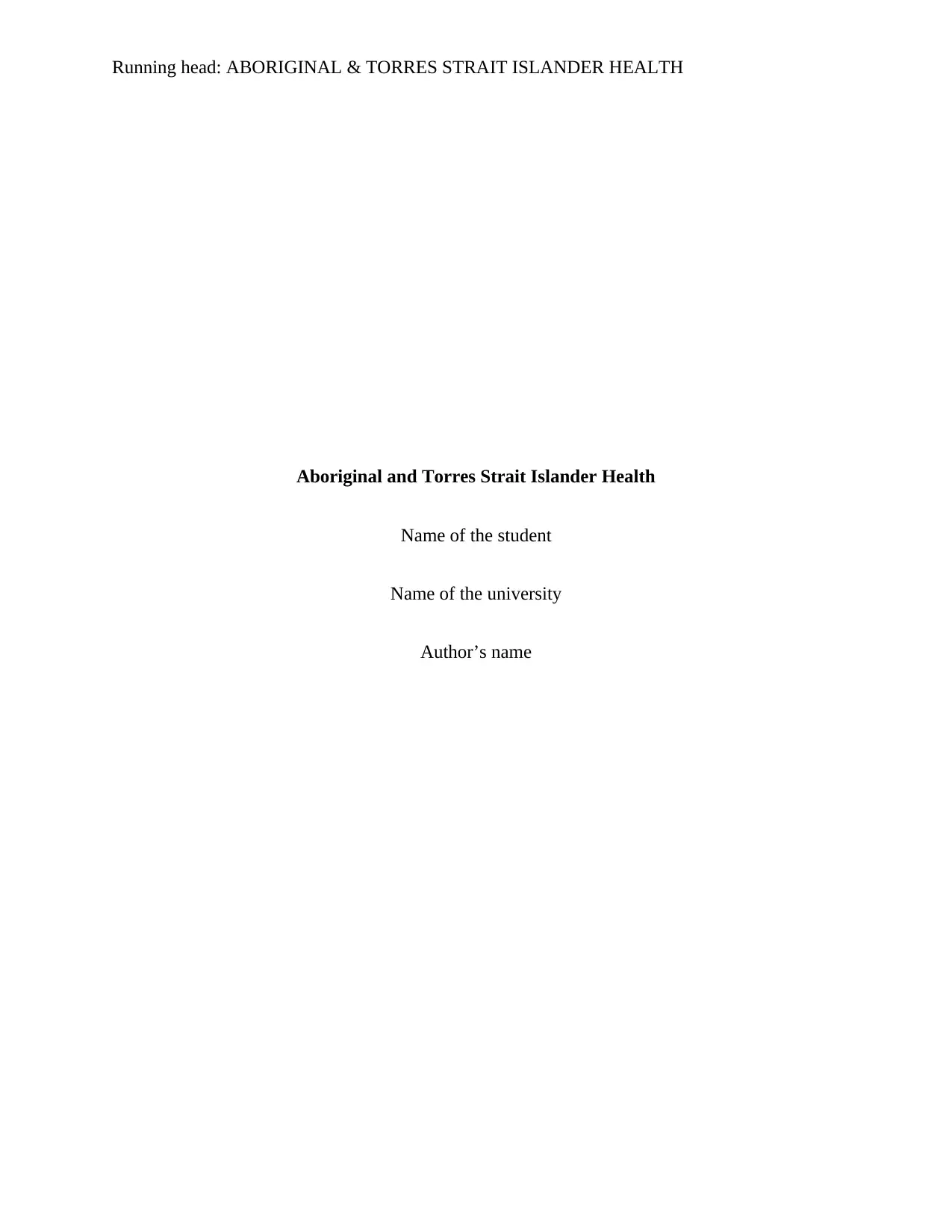
Running head: ABORIGINAL & TORRES STRAIT ISLANDER HEALTH
Aboriginal and Torres Strait Islander Health
Name of the student
Name of the university
Author’s name
Aboriginal and Torres Strait Islander Health
Name of the student
Name of the university
Author’s name
Secure Best Marks with AI Grader
Need help grading? Try our AI Grader for instant feedback on your assignments.
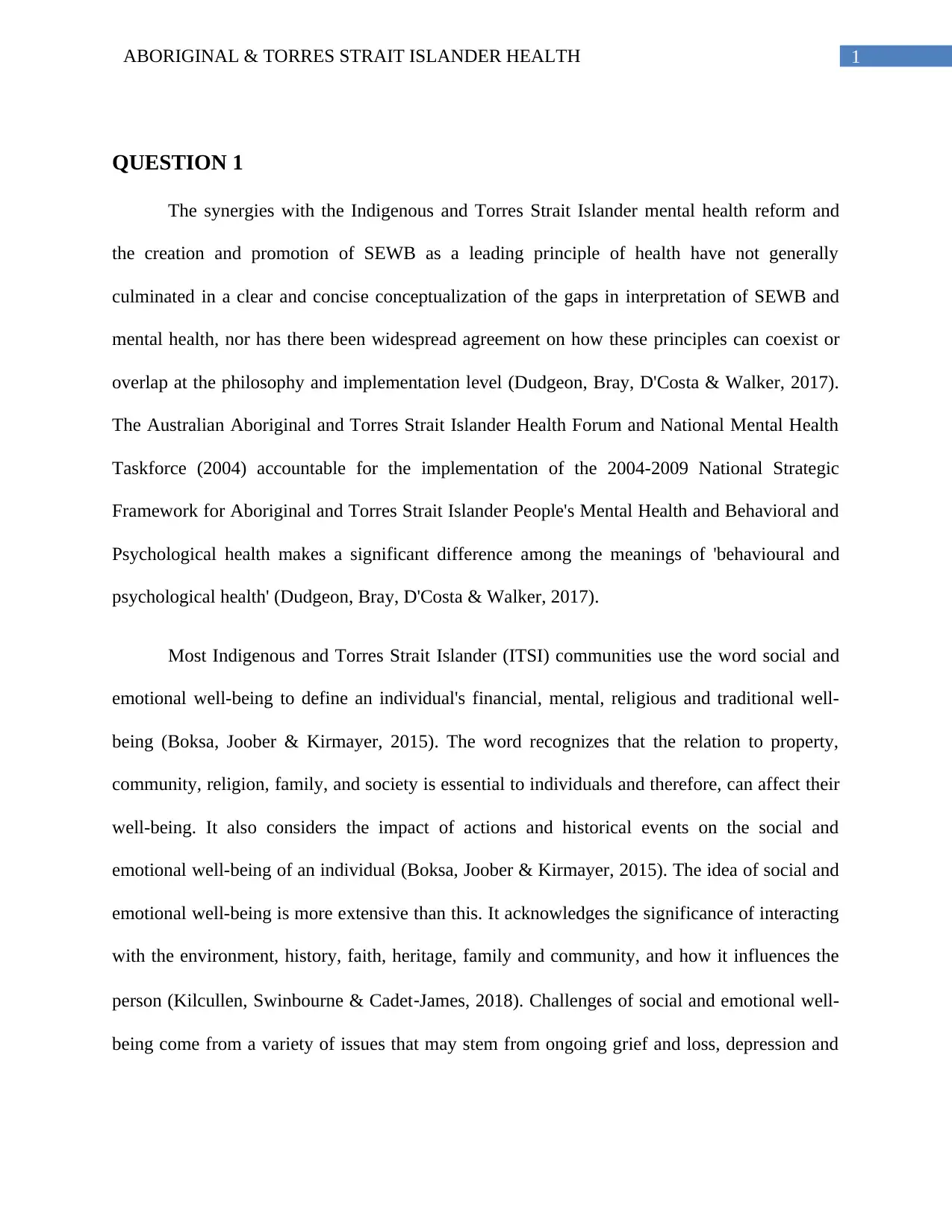
1ABORIGINAL & TORRES STRAIT ISLANDER HEALTH
QUESTION 1
The synergies with the Indigenous and Torres Strait Islander mental health reform and
the creation and promotion of SEWB as a leading principle of health have not generally
culminated in a clear and concise conceptualization of the gaps in interpretation of SEWB and
mental health, nor has there been widespread agreement on how these principles can coexist or
overlap at the philosophy and implementation level (Dudgeon, Bray, D'Costa & Walker, 2017).
The Australian Aboriginal and Torres Strait Islander Health Forum and National Mental Health
Taskforce (2004) accountable for the implementation of the 2004-2009 National Strategic
Framework for Aboriginal and Torres Strait Islander People's Mental Health and Behavioral and
Psychological health makes a significant difference among the meanings of 'behavioural and
psychological health' (Dudgeon, Bray, D'Costa & Walker, 2017).
Most Indigenous and Torres Strait Islander (ITSI) communities use the word social and
emotional well-being to define an individual's financial, mental, religious and traditional well-
being (Boksa, Joober & Kirmayer, 2015). The word recognizes that the relation to property,
community, religion, family, and society is essential to individuals and therefore, can affect their
well-being. It also considers the impact of actions and historical events on the social and
emotional well-being of an individual (Boksa, Joober & Kirmayer, 2015). The idea of social and
emotional well-being is more extensive than this. It acknowledges the significance of interacting
with the environment, history, faith, heritage, family and community, and how it influences the
person (Kilcullen, Swinbourne & Cadet‐James, 2018). Challenges of social and emotional well-
being come from a variety of issues that may stem from ongoing grief and loss, depression and
QUESTION 1
The synergies with the Indigenous and Torres Strait Islander mental health reform and
the creation and promotion of SEWB as a leading principle of health have not generally
culminated in a clear and concise conceptualization of the gaps in interpretation of SEWB and
mental health, nor has there been widespread agreement on how these principles can coexist or
overlap at the philosophy and implementation level (Dudgeon, Bray, D'Costa & Walker, 2017).
The Australian Aboriginal and Torres Strait Islander Health Forum and National Mental Health
Taskforce (2004) accountable for the implementation of the 2004-2009 National Strategic
Framework for Aboriginal and Torres Strait Islander People's Mental Health and Behavioral and
Psychological health makes a significant difference among the meanings of 'behavioural and
psychological health' (Dudgeon, Bray, D'Costa & Walker, 2017).
Most Indigenous and Torres Strait Islander (ITSI) communities use the word social and
emotional well-being to define an individual's financial, mental, religious and traditional well-
being (Boksa, Joober & Kirmayer, 2015). The word recognizes that the relation to property,
community, religion, family, and society is essential to individuals and therefore, can affect their
well-being. It also considers the impact of actions and historical events on the social and
emotional well-being of an individual (Boksa, Joober & Kirmayer, 2015). The idea of social and
emotional well-being is more extensive than this. It acknowledges the significance of interacting
with the environment, history, faith, heritage, family and community, and how it influences the
person (Kilcullen, Swinbourne & Cadet‐James, 2018). Challenges of social and emotional well-
being come from a variety of issues that may stem from ongoing grief and loss, depression and
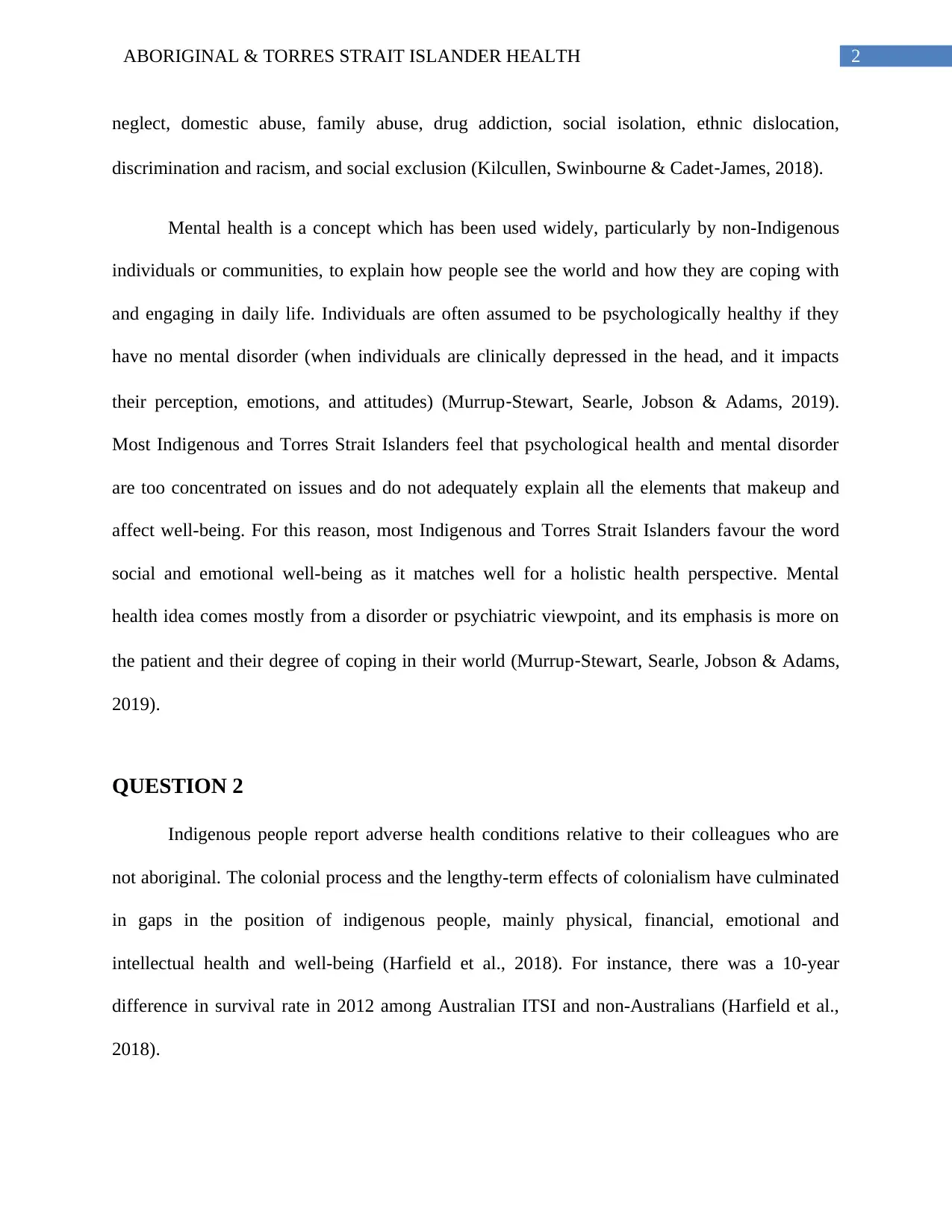
2ABORIGINAL & TORRES STRAIT ISLANDER HEALTH
neglect, domestic abuse, family abuse, drug addiction, social isolation, ethnic dislocation,
discrimination and racism, and social exclusion (Kilcullen, Swinbourne & Cadet‐James, 2018).
Mental health is a concept which has been used widely, particularly by non-Indigenous
individuals or communities, to explain how people see the world and how they are coping with
and engaging in daily life. Individuals are often assumed to be psychologically healthy if they
have no mental disorder (when individuals are clinically depressed in the head, and it impacts
their perception, emotions, and attitudes) (Murrup‐Stewart, Searle, Jobson & Adams, 2019).
Most Indigenous and Torres Strait Islanders feel that psychological health and mental disorder
are too concentrated on issues and do not adequately explain all the elements that makeup and
affect well-being. For this reason, most Indigenous and Torres Strait Islanders favour the word
social and emotional well-being as it matches well for a holistic health perspective. Mental
health idea comes mostly from a disorder or psychiatric viewpoint, and its emphasis is more on
the patient and their degree of coping in their world (Murrup‐Stewart, Searle, Jobson & Adams,
2019).
QUESTION 2
Indigenous people report adverse health conditions relative to their colleagues who are
not aboriginal. The colonial process and the lengthy-term effects of colonialism have culminated
in gaps in the position of indigenous people, mainly physical, financial, emotional and
intellectual health and well-being (Harfield et al., 2018). For instance, there was a 10-year
difference in survival rate in 2012 among Australian ITSI and non-Australians (Harfield et al.,
2018).
neglect, domestic abuse, family abuse, drug addiction, social isolation, ethnic dislocation,
discrimination and racism, and social exclusion (Kilcullen, Swinbourne & Cadet‐James, 2018).
Mental health is a concept which has been used widely, particularly by non-Indigenous
individuals or communities, to explain how people see the world and how they are coping with
and engaging in daily life. Individuals are often assumed to be psychologically healthy if they
have no mental disorder (when individuals are clinically depressed in the head, and it impacts
their perception, emotions, and attitudes) (Murrup‐Stewart, Searle, Jobson & Adams, 2019).
Most Indigenous and Torres Strait Islanders feel that psychological health and mental disorder
are too concentrated on issues and do not adequately explain all the elements that makeup and
affect well-being. For this reason, most Indigenous and Torres Strait Islanders favour the word
social and emotional well-being as it matches well for a holistic health perspective. Mental
health idea comes mostly from a disorder or psychiatric viewpoint, and its emphasis is more on
the patient and their degree of coping in their world (Murrup‐Stewart, Searle, Jobson & Adams,
2019).
QUESTION 2
Indigenous people report adverse health conditions relative to their colleagues who are
not aboriginal. The colonial process and the lengthy-term effects of colonialism have culminated
in gaps in the position of indigenous people, mainly physical, financial, emotional and
intellectual health and well-being (Harfield et al., 2018). For instance, there was a 10-year
difference in survival rate in 2012 among Australian ITSI and non-Australians (Harfield et al.,
2018).

3ABORIGINAL & TORRES STRAIT ISLANDER HEALTH
Aboriginal primary health care (PHC) programs evolved as a consequence of the
traditional health services ' failure to adequately address the requirements of aboriginal
communities (Reeve et al., 2015). The idea that indigenous populations have often been removed
and alienated from conventional healthcare services was also a reaction to the facts. Part of the
change was to create unique indigenous PHC programs for and operated by indigenous
populations (Harfield et al., 2018).
The first Aboriginal PHC program was founded in Australia in 1971, and more than 150
Aboriginal Community Based Health Services are now accessible across the world. Healthcare
reform in New Zealand in the early 1990s contributed to the growth of healthcare professionals
in Māori (Harfield et al., 2018). This has culminated in a mixture of national and local Māori-led
programs dedicated to enhancing the well-being of Māori. In Canada, the implementation of the
Health Transfer strategy in the late 1980s prompted the transition to the First Nation and Inuit
management of traditional society-based and municipal healthcare services, and much more
significantly the creation of First Nations and Inuit Health Authorities (Harfield et al., 2018). The
delivery of healthcare services to American Indians and Alaska Natives in the United States
started as early as the 19th century. It progressed with a series of legislative changes through the
1930s, 1950s and 1970s, resulting in what is now recognized as the Indian Health Services
(Harfield et al., 2018).
There are several explanations of why indigenous PHC programs are more likely to
increase the well-being of indigenous communities than traditional systems. Some of the critical
reasons for this is that their indigenous communities mostly regulate indigenous PHC systems
and thus are focused on the beliefs and values of the society in which they live (Harfield et al.,
2018). Their performance is indeed attributable to the idea that they sometimes include extensive
Aboriginal primary health care (PHC) programs evolved as a consequence of the
traditional health services ' failure to adequately address the requirements of aboriginal
communities (Reeve et al., 2015). The idea that indigenous populations have often been removed
and alienated from conventional healthcare services was also a reaction to the facts. Part of the
change was to create unique indigenous PHC programs for and operated by indigenous
populations (Harfield et al., 2018).
The first Aboriginal PHC program was founded in Australia in 1971, and more than 150
Aboriginal Community Based Health Services are now accessible across the world. Healthcare
reform in New Zealand in the early 1990s contributed to the growth of healthcare professionals
in Māori (Harfield et al., 2018). This has culminated in a mixture of national and local Māori-led
programs dedicated to enhancing the well-being of Māori. In Canada, the implementation of the
Health Transfer strategy in the late 1980s prompted the transition to the First Nation and Inuit
management of traditional society-based and municipal healthcare services, and much more
significantly the creation of First Nations and Inuit Health Authorities (Harfield et al., 2018). The
delivery of healthcare services to American Indians and Alaska Natives in the United States
started as early as the 19th century. It progressed with a series of legislative changes through the
1930s, 1950s and 1970s, resulting in what is now recognized as the Indian Health Services
(Harfield et al., 2018).
There are several explanations of why indigenous PHC programs are more likely to
increase the well-being of indigenous communities than traditional systems. Some of the critical
reasons for this is that their indigenous communities mostly regulate indigenous PHC systems
and thus are focused on the beliefs and values of the society in which they live (Harfield et al.,
2018). Their performance is indeed attributable to the idea that they sometimes include extensive
Secure Best Marks with AI Grader
Need help grading? Try our AI Grader for instant feedback on your assignments.

4ABORIGINAL & TORRES STRAIT ISLANDER HEALTH
services that include care and recovery, preventive and well-being promotion, as well as
recognizing health's socioeconomic factors (Harfield et al., 2018).
Indigenous PHC service delivery models are excellent PHC models that provide
healthcare services to indigenous populations and communities around the world, often to remote
individuals or areas where any other service provision model is feasible (Harfield et al., 2018).
Although there are many advantages of indigenous PHC service provision models, also there are
constraints: indigenous PHC service provision models do not comply with government support
mechanisms; there is often a lack of resources to provide particular indigenous PHC programs;
the need for facilities outweighs funding and program availability, and the provision of
healthcare services to indigenous populations (Harfield et al., 2018).
QUESTION 3
Social and emotional well-being (SEWB) for Indigenous Australians is a vital
determining factor of population health (Prehn, 2018). The health gap amongst Australia's
Aboriginal and Torres Strait Islanders and their non-Indigenous counterparts is the core business
for the ACCHS market (Prehn, 2018). The Closing, the Gap Program, undertakes to mitigate this
deficit, through cross-government initiatives and commitments that represent a need to enhance
the Indigenous community's social and emotional well-being. Primary health care practises
focused on diagnosis, early diagnosis and treatment planning, enhances these efforts to build
healthy neighbourhoods (Williamson et al., 2016). ACCHSs also eliminated systemic bias,
obstacles to access to health care, and are gradually improving individual health results for
Aboriginal people through their paradigm of holistic primary health care and collective
government. The Aboriginal Community Controlled Health Services (ACCHS) program is
services that include care and recovery, preventive and well-being promotion, as well as
recognizing health's socioeconomic factors (Harfield et al., 2018).
Indigenous PHC service delivery models are excellent PHC models that provide
healthcare services to indigenous populations and communities around the world, often to remote
individuals or areas where any other service provision model is feasible (Harfield et al., 2018).
Although there are many advantages of indigenous PHC service provision models, also there are
constraints: indigenous PHC service provision models do not comply with government support
mechanisms; there is often a lack of resources to provide particular indigenous PHC programs;
the need for facilities outweighs funding and program availability, and the provision of
healthcare services to indigenous populations (Harfield et al., 2018).
QUESTION 3
Social and emotional well-being (SEWB) for Indigenous Australians is a vital
determining factor of population health (Prehn, 2018). The health gap amongst Australia's
Aboriginal and Torres Strait Islanders and their non-Indigenous counterparts is the core business
for the ACCHS market (Prehn, 2018). The Closing, the Gap Program, undertakes to mitigate this
deficit, through cross-government initiatives and commitments that represent a need to enhance
the Indigenous community's social and emotional well-being. Primary health care practises
focused on diagnosis, early diagnosis and treatment planning, enhances these efforts to build
healthy neighbourhoods (Williamson et al., 2016). ACCHSs also eliminated systemic bias,
obstacles to access to health care, and are gradually improving individual health results for
Aboriginal people through their paradigm of holistic primary health care and collective
government. The Aboriginal Community Controlled Health Services (ACCHS) program is
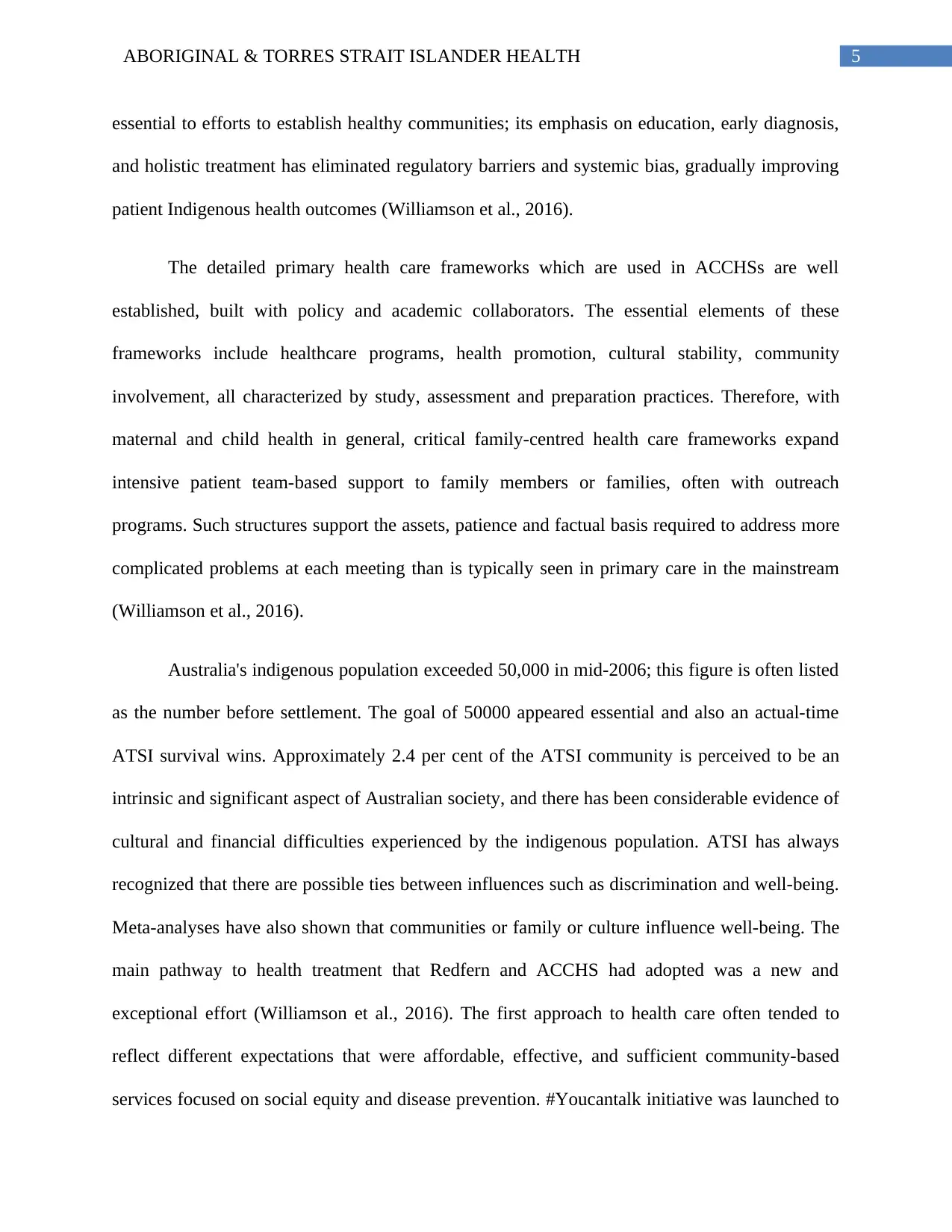
5ABORIGINAL & TORRES STRAIT ISLANDER HEALTH
essential to efforts to establish healthy communities; its emphasis on education, early diagnosis,
and holistic treatment has eliminated regulatory barriers and systemic bias, gradually improving
patient Indigenous health outcomes (Williamson et al., 2016).
The detailed primary health care frameworks which are used in ACCHSs are well
established, built with policy and academic collaborators. The essential elements of these
frameworks include healthcare programs, health promotion, cultural stability, community
involvement, all characterized by study, assessment and preparation practices. Therefore, with
maternal and child health in general, critical family-centred health care frameworks expand
intensive patient team-based support to family members or families, often with outreach
programs. Such structures support the assets, patience and factual basis required to address more
complicated problems at each meeting than is typically seen in primary care in the mainstream
(Williamson et al., 2016).
Australia's indigenous population exceeded 50,000 in mid-2006; this figure is often listed
as the number before settlement. The goal of 50000 appeared essential and also an actual-time
ATSI survival wins. Approximately 2.4 per cent of the ATSI community is perceived to be an
intrinsic and significant aspect of Australian society, and there has been considerable evidence of
cultural and financial difficulties experienced by the indigenous population. ATSI has always
recognized that there are possible ties between influences such as discrimination and well-being.
Meta-analyses have also shown that communities or family or culture influence well-being. The
main pathway to health treatment that Redfern and ACCHS had adopted was a new and
exceptional effort (Williamson et al., 2016). The first approach to health care often tended to
reflect different expectations that were affordable, effective, and sufficient community-based
services focused on social equity and disease prevention. #Youcantalk initiative was launched to
essential to efforts to establish healthy communities; its emphasis on education, early diagnosis,
and holistic treatment has eliminated regulatory barriers and systemic bias, gradually improving
patient Indigenous health outcomes (Williamson et al., 2016).
The detailed primary health care frameworks which are used in ACCHSs are well
established, built with policy and academic collaborators. The essential elements of these
frameworks include healthcare programs, health promotion, cultural stability, community
involvement, all characterized by study, assessment and preparation practices. Therefore, with
maternal and child health in general, critical family-centred health care frameworks expand
intensive patient team-based support to family members or families, often with outreach
programs. Such structures support the assets, patience and factual basis required to address more
complicated problems at each meeting than is typically seen in primary care in the mainstream
(Williamson et al., 2016).
Australia's indigenous population exceeded 50,000 in mid-2006; this figure is often listed
as the number before settlement. The goal of 50000 appeared essential and also an actual-time
ATSI survival wins. Approximately 2.4 per cent of the ATSI community is perceived to be an
intrinsic and significant aspect of Australian society, and there has been considerable evidence of
cultural and financial difficulties experienced by the indigenous population. ATSI has always
recognized that there are possible ties between influences such as discrimination and well-being.
Meta-analyses have also shown that communities or family or culture influence well-being. The
main pathway to health treatment that Redfern and ACCHS had adopted was a new and
exceptional effort (Williamson et al., 2016). The first approach to health care often tended to
reflect different expectations that were affordable, effective, and sufficient community-based
services focused on social equity and disease prevention. #Youcantalk initiative was launched to

6ABORIGINAL & TORRES STRAIT ISLANDER HEALTH
inspire and help people communicate as a national campaign. We have put their trust in talking
about suicide (Williamson et al., 2016).
inspire and help people communicate as a national campaign. We have put their trust in talking
about suicide (Williamson et al., 2016).
Paraphrase This Document
Need a fresh take? Get an instant paraphrase of this document with our AI Paraphraser

7ABORIGINAL & TORRES STRAIT ISLANDER HEALTH
References
Boksa, P., Joober, R., & Kirmayer, L. J. (2015). Mental wellness in Canada’s Aboriginal
communities: striving toward reconciliation. Journal of psychiatry & neuroscience:
JPN, 40(6), 363. doi: 10.1503/jpn.150309
Dudgeon, P., Bray, A., D'Costa, B., & Walker, R. (2017). Decolonising psychology: Validating
social and emotional wellbeing. Australian Psychologist, 52(4), 316-325.
doi:10.1111/ap.12294
Green, A., Abbott, P., Delaney, P., Patradoon-Ho, P., Delaney, J., Davidson, P. M., &
DiGiacomo, M. (2016). Navigating the journey of Aboriginal childhood disability: a
qualitative study of carers’ interface with services. BMC health services research, 16(1),
680. doi:10.1186/s12913-016-1926-0
Harfield, S. G., Davy, C., McArthur, A., Munn, Z., Brown, A., & Brown, N. (2018).
Characteristics of Indigenous primary health care service delivery models: a systematic
scoping review. Globalization and Health, 14(1), 12. doi:10.1186/s12992-018-0332-2
Kilcullen, M., Swinbourne, A., & Cadet‐James, Y. (2018). Aboriginal and Torres Strait Islander
health and wellbeing: Social emotional wellbeing and strengths‐based
psychology. Clinical Psychologist, 22(1), 16-26. doi:10.1111/cp.12112
Le Grande, M., Ski, C. F., Thompson, D. R., Scuffham, P., Kularatna, S., Jackson, A. C., &
Brown, A. (2017). Social and emotional wellbeing assessment instruments for use with
Indigenous Australians: A critical review. Social Science & Medicine, 187, 164-173. Doi:
https://doi.org/10.1016/j.socscimed.2017.06.046
References
Boksa, P., Joober, R., & Kirmayer, L. J. (2015). Mental wellness in Canada’s Aboriginal
communities: striving toward reconciliation. Journal of psychiatry & neuroscience:
JPN, 40(6), 363. doi: 10.1503/jpn.150309
Dudgeon, P., Bray, A., D'Costa, B., & Walker, R. (2017). Decolonising psychology: Validating
social and emotional wellbeing. Australian Psychologist, 52(4), 316-325.
doi:10.1111/ap.12294
Green, A., Abbott, P., Delaney, P., Patradoon-Ho, P., Delaney, J., Davidson, P. M., &
DiGiacomo, M. (2016). Navigating the journey of Aboriginal childhood disability: a
qualitative study of carers’ interface with services. BMC health services research, 16(1),
680. doi:10.1186/s12913-016-1926-0
Harfield, S. G., Davy, C., McArthur, A., Munn, Z., Brown, A., & Brown, N. (2018).
Characteristics of Indigenous primary health care service delivery models: a systematic
scoping review. Globalization and Health, 14(1), 12. doi:10.1186/s12992-018-0332-2
Kilcullen, M., Swinbourne, A., & Cadet‐James, Y. (2018). Aboriginal and Torres Strait Islander
health and wellbeing: Social emotional wellbeing and strengths‐based
psychology. Clinical Psychologist, 22(1), 16-26. doi:10.1111/cp.12112
Le Grande, M., Ski, C. F., Thompson, D. R., Scuffham, P., Kularatna, S., Jackson, A. C., &
Brown, A. (2017). Social and emotional wellbeing assessment instruments for use with
Indigenous Australians: A critical review. Social Science & Medicine, 187, 164-173. Doi:
https://doi.org/10.1016/j.socscimed.2017.06.046
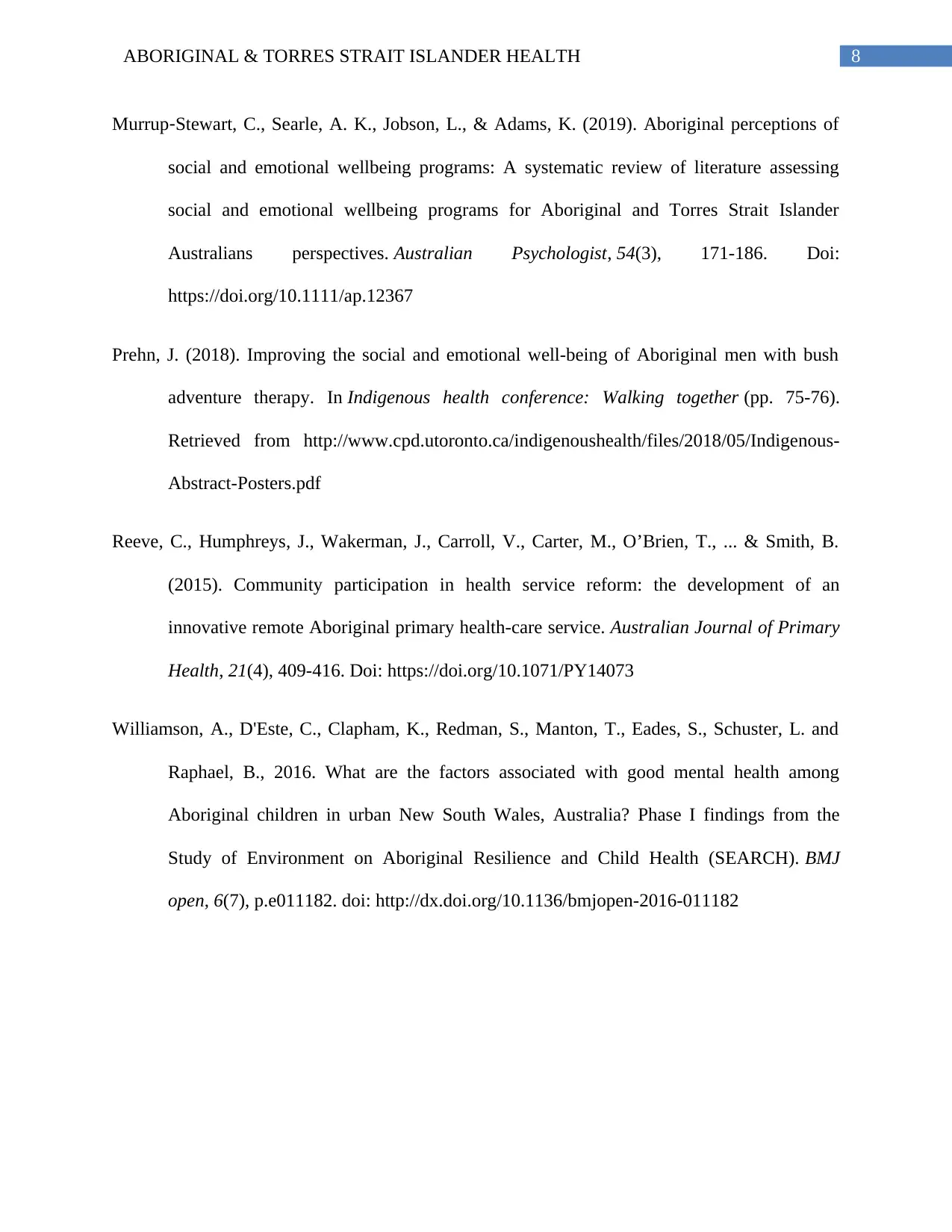
8ABORIGINAL & TORRES STRAIT ISLANDER HEALTH
Murrup‐Stewart, C., Searle, A. K., Jobson, L., & Adams, K. (2019). Aboriginal perceptions of
social and emotional wellbeing programs: A systematic review of literature assessing
social and emotional wellbeing programs for Aboriginal and Torres Strait Islander
Australians perspectives. Australian Psychologist, 54(3), 171-186. Doi:
https://doi.org/10.1111/ap.12367
Prehn, J. (2018). Improving the social and emotional well-being of Aboriginal men with bush
adventure therapy. In Indigenous health conference: Walking together (pp. 75-76).
Retrieved from http://www.cpd.utoronto.ca/indigenoushealth/files/2018/05/Indigenous-
Abstract-Posters.pdf
Reeve, C., Humphreys, J., Wakerman, J., Carroll, V., Carter, M., O’Brien, T., ... & Smith, B.
(2015). Community participation in health service reform: the development of an
innovative remote Aboriginal primary health-care service. Australian Journal of Primary
Health, 21(4), 409-416. Doi: https://doi.org/10.1071/PY14073
Williamson, A., D'Este, C., Clapham, K., Redman, S., Manton, T., Eades, S., Schuster, L. and
Raphael, B., 2016. What are the factors associated with good mental health among
Aboriginal children in urban New South Wales, Australia? Phase I findings from the
Study of Environment on Aboriginal Resilience and Child Health (SEARCH). BMJ
open, 6(7), p.e011182. doi: http://dx.doi.org/10.1136/bmjopen-2016-011182
Murrup‐Stewart, C., Searle, A. K., Jobson, L., & Adams, K. (2019). Aboriginal perceptions of
social and emotional wellbeing programs: A systematic review of literature assessing
social and emotional wellbeing programs for Aboriginal and Torres Strait Islander
Australians perspectives. Australian Psychologist, 54(3), 171-186. Doi:
https://doi.org/10.1111/ap.12367
Prehn, J. (2018). Improving the social and emotional well-being of Aboriginal men with bush
adventure therapy. In Indigenous health conference: Walking together (pp. 75-76).
Retrieved from http://www.cpd.utoronto.ca/indigenoushealth/files/2018/05/Indigenous-
Abstract-Posters.pdf
Reeve, C., Humphreys, J., Wakerman, J., Carroll, V., Carter, M., O’Brien, T., ... & Smith, B.
(2015). Community participation in health service reform: the development of an
innovative remote Aboriginal primary health-care service. Australian Journal of Primary
Health, 21(4), 409-416. Doi: https://doi.org/10.1071/PY14073
Williamson, A., D'Este, C., Clapham, K., Redman, S., Manton, T., Eades, S., Schuster, L. and
Raphael, B., 2016. What are the factors associated with good mental health among
Aboriginal children in urban New South Wales, Australia? Phase I findings from the
Study of Environment on Aboriginal Resilience and Child Health (SEARCH). BMJ
open, 6(7), p.e011182. doi: http://dx.doi.org/10.1136/bmjopen-2016-011182
1 out of 9
Related Documents
Your All-in-One AI-Powered Toolkit for Academic Success.
+13062052269
info@desklib.com
Available 24*7 on WhatsApp / Email
![[object Object]](/_next/static/media/star-bottom.7253800d.svg)
Unlock your academic potential
© 2024 | Zucol Services PVT LTD | All rights reserved.





